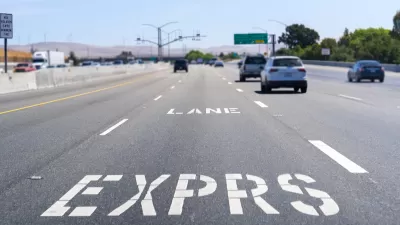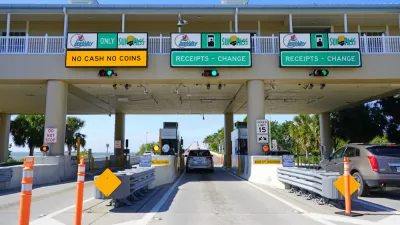East Palo Alto has long suffered the toll that transbay traffic has imposed on this gateway to Silicon Valley from the East Bay in the form of air pollution and traffic congestion. Now the city is considering tolling the traffic.

On Oct. 12, Gov. Gavin Newsom vetoed legislation by Assemblyman Phil Ting (D-San Francisco) which would have enabled the San Francisco County Transportation Agency to implement its Crooked Street Project on two blocks of Lombard Street, a popular tourist destination. The program was described as a "reservation and pricing program," an unusual form of road pricing.
Four days earlier and 32 miles south of San Francisco at the southern tip of San Mateo County along San Francisco Bay, the East Palo Alto City Council "discussed ways to reduce and manage traffic in the town, and one of the options discussed was whether to have a type of toll, called congestion pricing, on University Avenue [State Route 109] as a way to deter commuters," reports Emily Mibach for the Palo Alto Daily Post on Oct. 18.
Credit: Google maps. Also, see the image map in the Daily Post.
East Palo Alto officials have not picked which option they would like to pursue, but many obstacles still stand in the way of being able to enact such a plan.
At the council’s Oct. 8 meeting, most council members said they want Public Works Director Kamal Fallaha and his team to keep looking into whether charging drivers to use University is a possibility.
The Lombard Street reservation and pricing system and a possible University Avenue tolling scheme share little in common other than both would put a price on driving, and therefore require state legislation. While the challenges ahead for East Palo Alto are formidable, having to find a legislator to write a bill and get it approved by the legislature, as Assembly Bill 1605 did, the reason for the governor's veto, his concern over social equity, could possibly be a reason for attaching his signature. The relatively young city illustrates the huge "divide between rich and poor in Silicon Valley."
Cut through traffic prompts tolling consideration
The surprising decision to consider tolling a congested state route through an air pollution-burdened majority-minority city, where whites comprise about seven percent of the population, resulted from a mobility study that the Public Works Department launched two years ago with a community meeting. The study dealt with eight transportation issues, including parking, pedestrian-bicycle improvements, and changing to the new vehicle miles traveled standard to comply with the new California Environmental Quality Act principles.
"East Palo Alto suffers from significant cut through traffic," states the background section of the study on the city's webpage.
84% of the trips on University Ave. neither originate nor designate [sic] in East Palo Alto. East Palo Alto has the highest rates of asthma in the County. East Palo Alto also has among the highest transit propensities and highest rates of trips by pedestrians and bicycles in the County.
Study details
Evaluate Cut-Through Traffic and Develop Strategies to reduce it: The Study will evaluate potential strategies for minimizing or reducing cut through traffic, including congestion pricing; capital investments (speed humps and mid block chokers); and increased regulatory controls.
Generally speaking, cut-through traffic would apply to motor vehicles leaving a congested arterial to use local streets as an alternative. However, it would appear that the study may view all traffic on University Ave that doesn't originate or end in the city as cut-through. A response to an email to the city for clarification wasn't received prior to posting.
The 2019 East Palo Alto Mobility Survey [pdf] noted that the toll would only apply during peak hours, thus meeting the definition of congestion pricing.
"Councilman Carlos Romero said he’s been told by some at the Metropolitan Transportation Commission [Bay Area metropolitan planning organization] that it’s unlikely the city will get a legislator behind the tolls. Romero also said he wants to hear from Menlo Park and maybe Palo Alto on the toll roads," adds Mibach of the Post.
Another hurdle deals with the issue of "double-tolling" that is an issue with the Manhattan cordon pricing program that was approved last April by the New York State legislature. Motorists traveling through the city from the East Bay would have already paid a $3 (carpool) or $6 toll to cross the Dumbarton Bridge from Alameda County.
The city council "will re-examine the proposal in December," reports NBC Bay Area (see newscast video).
FUSE, a national nonprofit that partners with local government overcome challenges, is actively engaged with the city to improve mobility and health. Fallaha, the Public Works director, "also believes the idea is worth pursuing," wrote Nick Keppler for FUSE in August. “If they’re using our streets, they should pay their way,” he said.
I suspect Planetizen contributor Todd Litman, executive director of the Victoria Transport Policy Institute and a Planetizen contributor, would approve – see his Sept. 19 blog post, "Stop Giving Away Valuable Public Assets! A Fiduciary Obligation for Road and Parking Pricing."
Other related posts in Planetizen:
-
Portland Ready to Experiment With New Forms of Road Pricing, Oct. 21, 2019
-
Social Equity Cited in Veto of California Road Pricing Bill, Oct. 18, 2019
-
Crooked Lombard Street Won't Be Tolled After All, Oct. 15, 2019
-
Urban Congestion Pricing Might Finally Come to California, September 9, 2019
Hat tip to the International Bridge, Tunnel & Turnpike Association (IBTTA) – SmartBrief.
FULL STORY: East Palo Alto looking into making University Avenue a toll road

Planetizen Federal Action Tracker
A weekly monitor of how Trump’s orders and actions are impacting planners and planning in America.

Congressman Proposes Bill to Rename DC Metro “Trump Train”
The Make Autorail Great Again Act would withhold federal funding to the system until the Washington Metropolitan Area Transit Authority (WMATA), rebrands as the Washington Metropolitan Authority for Greater Access (WMAGA).

The Simple Legislative Tool Transforming Vacant Downtowns
In California, Michigan and Georgia, an easy win is bringing dollars — and delight — back to city centers.

The States Losing Rural Delivery Rooms at an Alarming Pace
In some states, as few as 9% of rural hospitals still deliver babies. As a result, rising pre-term births, no adequate pre-term care and "harrowing" close calls are a growing reality.

The Small South Asian Republic Going all in on EVs
Thanks to one simple policy change less than five years ago, 65% of new cars in this Himalayan country are now electric.

DC Backpedals on Bike Lane Protection, Swaps Barriers for Paint
Citing aesthetic concerns, the city is removing the concrete barriers and flexposts that once separated Arizona Avenue cyclists from motor vehicles.
Urban Design for Planners 1: Software Tools
This six-course series explores essential urban design concepts using open source software and equips planners with the tools they need to participate fully in the urban design process.
Planning for Universal Design
Learn the tools for implementing Universal Design in planning regulations.
Smith Gee Studio
City of Charlotte
City of Camden Redevelopment Agency
City of Astoria
Transportation Research & Education Center (TREC) at Portland State University
US High Speed Rail Association
City of Camden Redevelopment Agency
Municipality of Princeton (NJ)




























